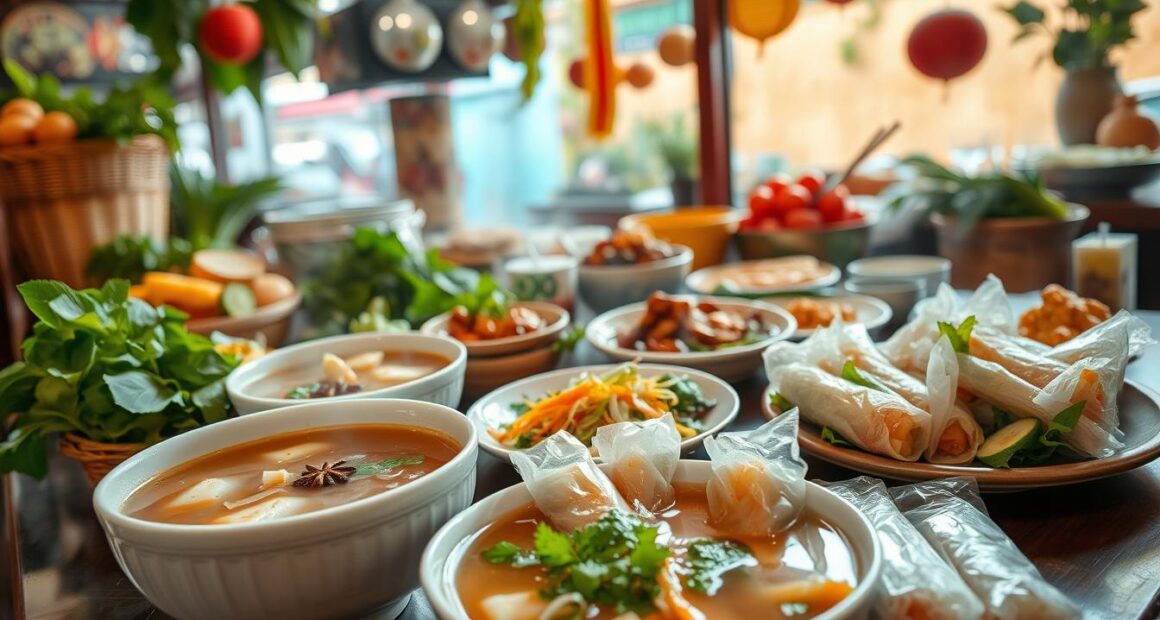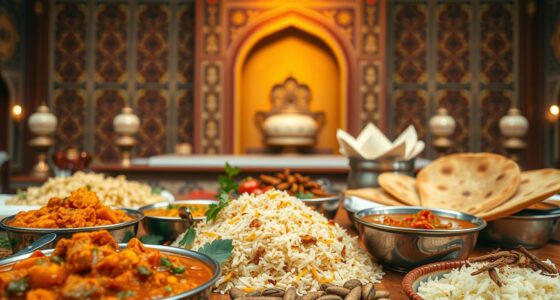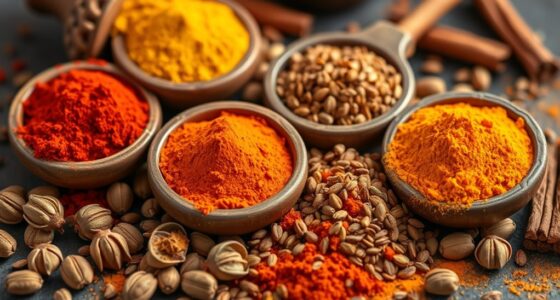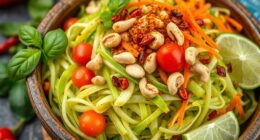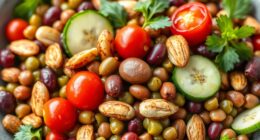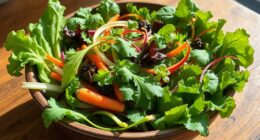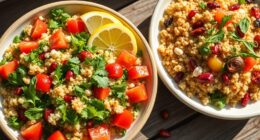Imagine standing in the heart of a bustling Vietnamese market, the air saturated with aromatic herbs and the delightful sizzle of street food vendors preparing local favorites. Vietnamese cuisine beckons you with its vibrant flavors and fresh ingredients, each dish a tapestry woven from centuries of tradition and cultural exchange. Whether you’ve savored a warm bowl of pho or enjoyed the crisp bite of a banh mi, you know that authentic Vietnamese food offers an unparalleled experience that tantalizes the senses.
At its core, Vietnamese culinary artistry revolves around the harmonious balance of five fundamental taste elements: spicy, sour, bitter, salty, and sweet. This approach ensures that every meal is not only a feast for the palate but also a celebration of freshness and diversity. Let’s embark on a journey through the delightful landscape of Vietnamese dishes, uncovering the unique flavors and culinary techniques that make this cuisine a global sensation.
Key Takeaways
- Vietnamese cuisine is celebrated for its balance of five taste elements: spicy, sour, bitter, salty, and sweet.
- Pho, the iconic noodle soup, has captured hearts worldwide, often made with beef or chicken.
- Banh mi blends Western and Eastern influences, making it a beloved street food item.
- Fresh spring rolls (goi cuon) are a healthy snack that showcases the freshness of Vietnamese ingredients.
- Regional diversity enriches the cuisine, with unique dishes emerging from Northern, Central, and Southern Vietnam.
A Brief Introduction to Vietnamese Cuisine
Vietnamese cuisine is a vibrant tapestry woven from fresh ingredients and diverse cultural influences. Renowned for its balance of flavors and emphasis on health, this cuisine embodies a dietary philosophy that prioritizes vitality. From the bustling streets of Ho Chi Minh City to the peaceful corners of Hanoi, you will encounter a plethora of popular Vietnamese dishes that not only satisfy the taste buds but also nourish the body.
What Makes It Unique?
The uniqueness of Vietnamese cuisine lies in its emphasis on fresh, locally-sourced ingredients. Dishes are typically prepared shortly before consumption, ensuring that each flavor remains vibrant. This culinary approach attracts food enthusiasts seeking authentic experiences. You will often find traditional Vietnamese recipes featuring a variety of tastes, including sweet, sour, salty, and spicy, all harmoniously balanced to create a complex yet enjoyable flavor profile.
Key Ingredients Used in Vietnamese Cooking
Essential components of Vietnamese cuisine include jasmine rice, rice noodles, and fish sauce, known locally as nước mắm. Fish sauce is particularly significant, as it serves as a foundational flavoring agent used in marinades, broths, and dressings. Fresh herbs play a vital role, with ingredients like cilantro, mint, and basil adding layers of flavor in many dishes. Meats such as pork and chicken are frequently highlighted in traditional Vietnamese recipes, creating scrumptious options for any meal.
Influences on Vietnamese Culinary Traditions
The culinary landscape of Vietnam has been shaped by a variety of influences, most notably from neighboring countries and French colonialism. This blend results in a unique culinary identity that is distinctly Vietnamese, even when borrowing elements from Chinese, Cambodian, or Malaysian cuisines. Dishes like pho exemplify this blend, featuring rice noodles paired with French-inspired broths, showcasing how traditional Vietnamese recipes can seamlessly combine elements from various cultures.
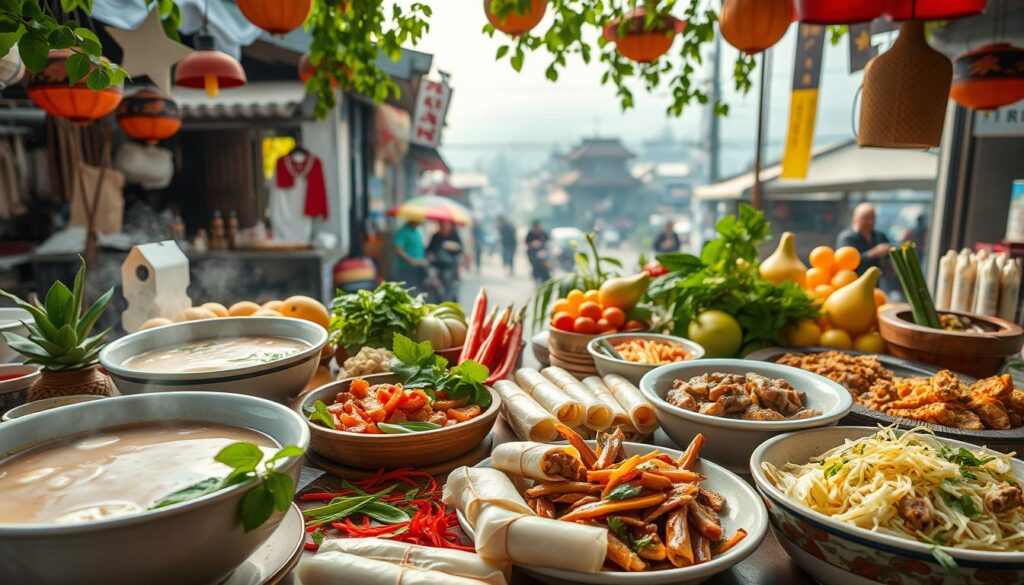
Popular Vietnamese Dishes to Try
Vietnamese cuisine is a vibrant tapestry of flavors and textures, showcasing an impressive variety of popular Vietnamese dishes. Each dish tells a story, reflecting the culture and history of the region. When exploring authentic Vietnamese food, certain iconic dishes stand out for their unique qualities and widespread popularity.
Pho: The Iconic Noodle Soup
Pho is often regarded as the quintessential Vietnamese dish. This noodle soup is deeply rooted in local culture, commonly enjoyed for breakfast. With either beef or chicken as the main protein, pho features a fragrant broth that is simmered for hours, allowing the flavors to meld beautifully. Variants such as Pho Hanoi are known for their clear broth, while Pho Nam boasts a murkier soup complemented by an array of fresh herbs, making it a must-try in any Vietnamese food experience.
Banh Mi: The Perfect Sandwich
Banh Mi exemplifies the fusion of French and Vietnamese influences in cuisine. This delightful sandwich features a crispy baguette filled with a medley of ingredients, including a variety of meats, fresh vegetables, and aromatic herbs. Banh Mi not only highlights the creativity of Vietnamese street food but also offers a taste of the country’s rich culinary history.
Goi Cuon: Fresh Spring Rolls
Goi Cuon, often referred to as fresh spring rolls, are a refreshing highlight among popular Vietnamese dishes. These rolls, typically filled with a mix of colorful vegetables, fragrant herbs, and proteins like shrimp or pork, are wrapped in delicate rice paper. Served with a variety of dipping sauces, goi cuon is a great way to enjoy authentic Vietnamese food, offering a burst of freshness in every bite.

The Role of Herbs and Spices
Herbs and spices form the backbone of Vietnamese cuisine, bringing vibrant flavors and freshness to every dish. As you explore various Vietnamese dishes, it becomes clear that the thoughtful use of herbs and spices is what sets this cuisine apart. The essential herbs used in these dishes create a balance of flavors that enhance your dining experience.
Essential Herbs in Vietnamese Dishes
Spring onion, or hành lá, is the most widely used herb in Vietnamese cooking, frequently acting as a garnish in soups and stir-fries. Coriander, known as ngò rí, complements spring onions beautifully, with northern coriander providing a stronger fragrance than its southern counterpart. Garlic chives (hẹ) serve a dual purpose as both a vegetable and herb, varying in size and flavor according to different regions.
Dill (thì là) holds a special place in Hà Nội’s famous fish dish, chả cá Lã Vọng, effectively reducing any fishy odors. Culantro (ngò gai) is essential in southern sweet and sour soups, offering a unique taste while being a staple in traditional remedies. Rice paddy herb (ngò om) and Vietnamese coriander (rau răm) enrich dishes like phở, elevating their flavor profiles.
Balancing Flavors: Sweet, Sour, Salty, and Spicy
In Vietnamese cooking techniques, balancing flavors plays a crucial role. The distinctive qualities of sweet, sour, salty, and spicy elements often come together in harmony. Ingredients such as fish sauce enhance these flavors, creating a delightful experience. The ritual of adding fresh herbs to each bite allows diners to customize their taste, bringing out the full potential of the dish.
With dishes like phở and bún bò Huế featuring an array of aromatic herbs, diners enjoy the sensory delight of combining fragrant herbs with robust flavors. This thoughtful integration emphasizes the importance of herbs and spices in Vietnamese cuisine, making each meal a journey of taste.
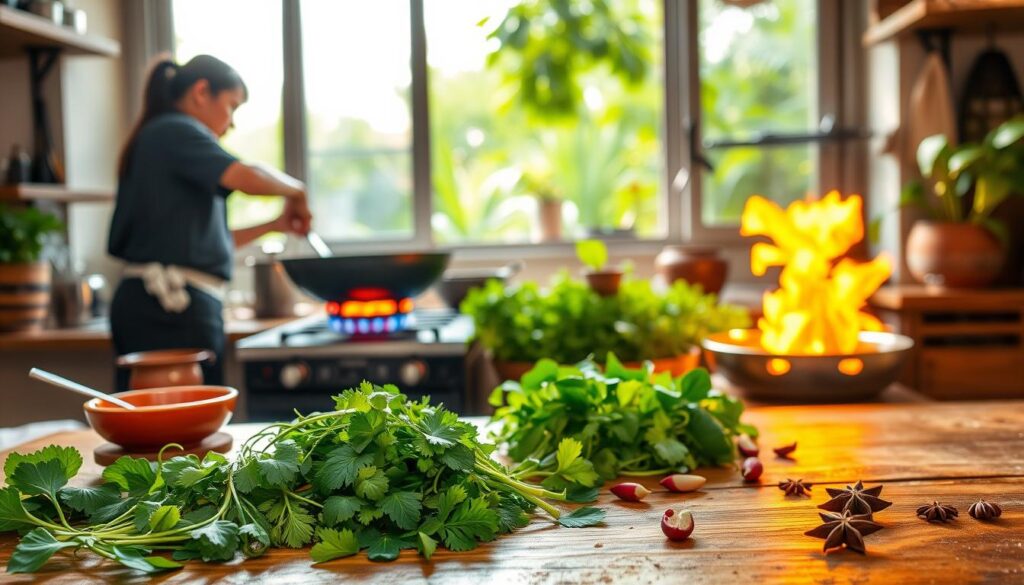
Regional Variations in Vietnamese Cuisine
Vietnamese cuisine is a vibrant tapestry of flavors influenced by regional differences. Each region boasts unique characteristics that contribute to an authentic Vietnamese food experience. Here’s a closer look at the culinary delights from Northern, Central, and Southern Vietnam.
Northern Vietnam: A Taste of the North
Northern Vietnamese cuisine stands out for its subtle and balanced flavors. With a focus on fresh herbs and rice, dishes here often have a delicately sour taste complemented by moderate seasoning. The use of spices is limited, with black pepper being the primary hot ingredient. Popular dishes such as pho and bun cha showcase this culinary style, reflecting the diverse array of meats and crustaceans used, including pork, beef, and freshwater fish.
Central Vietnam: Spice and Variety
Traveling south, the Central region is known for its hot and spicy cuisine. The food here is a colorful mix, influenced by ancient royal traditions, showcasing a complex presentation and a variety of flavors. Notable dishes include mì Quảng and the famed Hue cuisine, which boasts around 1,300 distinct recipes, many still preserved today. Central Vietnamese flavors include salty, sweet, and bitter notes, often highlighted by fresh herbs and prominent chilies.
Southern Vietnam: Rich and Flavorful
The southern part of Vietnam favors a richer, sweeter flavor profile, relying heavily on coconut milk and sugar. The abundance of fruits and vegetables in the fertile lands translates into vibrant dishes, often highlighting seafood. Iconic meals such as Banh Khoai and Goi Cuon shine in this culinary environment. With influences from various cultures, including French and Chinese, the bustling food scene in cities like Ho Chi Minh City is a must for any fan of authentic Vietnamese food.
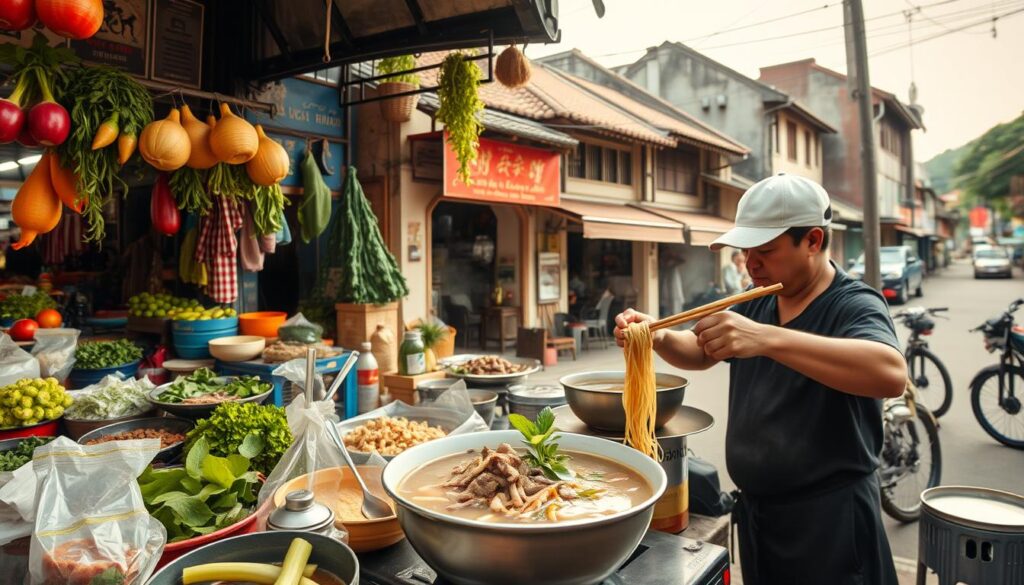
Essential Cooking Techniques in Vietnamese Cuisine
Understanding Vietnamese cooking techniques can significantly enhance your culinary experience. Each method showcases the vibrant flavors and freshness that characterize traditional Vietnamese recipes. From quick stir-fries to gentle steaming, these techniques highlight the importance of fresh ingredients and rich flavors.
Stir-Frying: The Fast and Flavorful Method
Stir-frying stands out as a prevalent cooking method in Vietnamese cuisine. This technique allows you to prepare meals in just a few minutes, maintaining the vibrant colors and nutrients of the ingredients. It’s particularly popular for dishes packed with fresh vegetables and proteins, contributing to a healthy yet flavorful meal. About 25% of popular Vietnamese dishes utilize pan-frying, demonstrating the preference for crispy textures. Here are some key aspects of stir-frying:
- Quick Cooking: Retains the freshness of ingredients.
- Rich Flavors: Enhances the taste while preserving nutrients.
- Versatility: Ideal for various meats and vegetables.
Steaming: A Healthy Cooking Technique
Steaming is a vital technique in Vietnamese cooking, often used for preparing traditional dishes like rice cakes and dumplings. This method keeps ingredients moist without the use of additional oil, making it a healthy choice. Steaming comprises about 15% of traditional Vietnamese recipes, showcasing its importance in health-conscious cooking. Key benefits of steaming include:
- Preservation of Nutrients: Maintains the natural flavors and nutrients of food.
- Low-Fat Preparation: No additional oils make it healthier.
- Ideal for Vegetables: Retains the vibrant colors and textures.
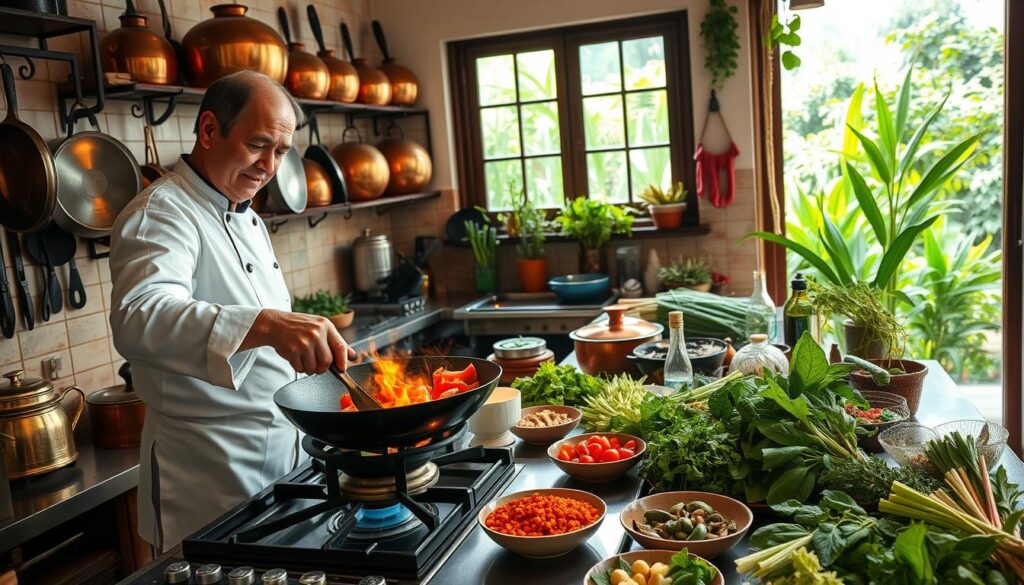
Street Food Culture in Vietnam
The vibrant world of Vietnamese street food captivates food lovers with its unique flavors, tempting aromas, and communal atmosphere. You’ll find that many stalls take pride in offering authentic Vietnamese food through specialized dishes, making each meal a delightful experience. Here are some must-try options that showcase the culinary diversity of the country.
Must-Try Street Foods in Vietnam
- Bánh Xèo: These crispy pancakes, filled with ingredients like shrimp, pork, and bean sprouts, are sizzling delights that are best enjoyed fresh and hot.
- Bún Chả: This dish features flavorful grilled pork served over vermicelli noodles, garnished with fresh herbs and dipping sauce, making it a favorite in bustling markets.
- Bún Riêu: A savory soup combining crab, tomatoes, and tofu, accompanied by herbs, provides a comforting and satisfying meal.
- Gỏi Cuốn: Known as summer rolls, these fresh, do-it-yourself rolls are filled with shrimp and herbs, allowing diners to enjoy a hands-on culinary experience.
- Bò Kho: This aromatic beef stew, infused with lemongrass and spices, is perfect for those looking for something hearty and flavorful.
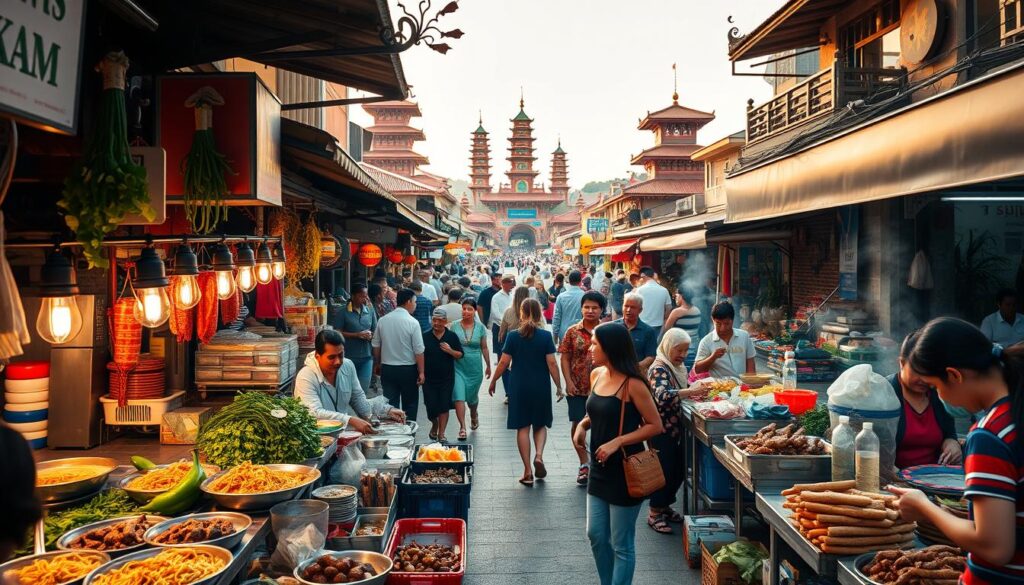
How to Enjoy Street Food Responsibly
When indulging in the delights of Vietnamese street food, you want to ensure a great experience by following some simple guidelines. Choose stalls that are busy, as a high volume of local customers is usually a good sign of quality and taste. During peak dining hours—such as 6 pm to 8 pm—people share tables, creating a friendly and communal atmosphere. Remember that many vendors specialize in two or three signature dishes; this focus often results in higher quality meals.
Prioritize cleanliness when selecting a stall. When you order, you may notice that payment is often made directly to the chef without a written bill, a practice common in local dining culture. Lastly, don’t forget to savor the complimentary fresh herbs and leafy greens that accompany many noodle dishes, as they highlight the emphasis on using fresh ingredients in authentic Vietnamese food.
Exploring Vietnamese Sauces and Condiments
In the realm of authentic Vietnamese food, sauces and condiments stand out for their ability to enhance flavors and elevate dishes. Understanding these Vietnamese sauces is essential for anyone looking to appreciate the depth of this cuisine. Among the most notable sauces are Nuoc Cham and flavor powerhouses like Hoisin and Sriracha.
Nuoc Cham: The All-Purpose Dipping Sauce
Considered Vietnam’s mother sauce, Nuoc Cham plays a critical role in many meals. This versatile dipping sauce consists of a harmonious blend featuring fish sauce, lime juice, sugar, garlic, and chili peppers. Its balance of sweet, tangy, and salty flavors makes it the mildest among Vietnamese sauces. You can typically enjoy Nuoc Cham alongside dishes like egg rolls and other appetizers, enhancing their taste with every dip.
Hoisin and Sriracha: Flavor Powerhouses
Hoisin and Sriracha sauces have carved out their place in Vietnamese culinary traditions. These flavor-packed sauces often accompany various dishes, adding a rich depth to authentic Vietnamese food. Hoisin delivers a sweet and savory essence, while Sriracha offers a spicy kick that can elevate any meal. Both sauces are popular choices for enhancing the experience of dining on Vietnamese cuisine.
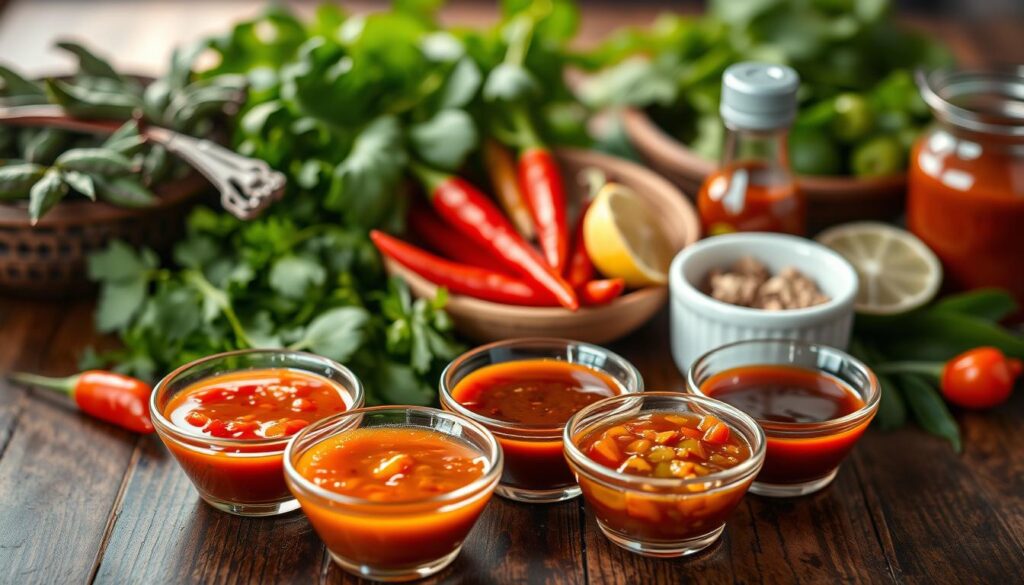
The Influence of French Colonialism
The interplay of cultures during the French colonial period has had a significant impact on Vietnamese cuisine, particularly in the development of various dishes and culinary techniques. The fusion created between traditional Vietnamese recipes and French influences is a noteworthy aspect of the country’s culinary evolution.
French-influenced Dishes in Vietnam
One of the most iconic examples is Bánh Mì, a delicious sandwich that features a uniquely Vietnamese twist on the French baguette. Made from rice flour, this bread is distinct in flavor and texture compared to its French counterpart. The bánh mì is filled with grilled meats, pickled vegetables, coriander, and often pâté, embodying the harmonious blending of these two culinary traditions.
Phở is another classic dish, a fragrant noodle soup that showcases the influence of French cooking methods, particularly the use of meat broths. The recipe’s roots may trace back to the French ‘pot au feu,’ reflecting the interconnectedness of these cuisines.
Breads and Pastries: A Culinary Fusion
Vietnamese pastries and breads also demonstrate this culinary fusion. For instance, bánh bao, a type of steamed bun, reveals the adoption of French pastry techniques while incorporating local flavors. The adaptation of dairy products, though minimal before French arrival, blended in smoothly as coffee culture evolved. Notably, the Vietnamese version of coffee, traditionally brewed strong and served iced with sweetened condensed milk, highlights this continuing influence.
| Dish | Description |
|---|---|
| Bánh Mì | A Vietnamese sandwich with grilled meat, vegetables, and a rice-flour baguette. |
| Phở | Noodle soup with beef broth, influenced by French soup-making traditions. |
| Bánh Bao | Steamed buns that incorporate French baking techniques and Vietnamese flavors. |
| Vietnamese Coffee | Strong coffee served iced, mixed with sweetened condensed milk, showcasing a fusion with French coffee styles. |
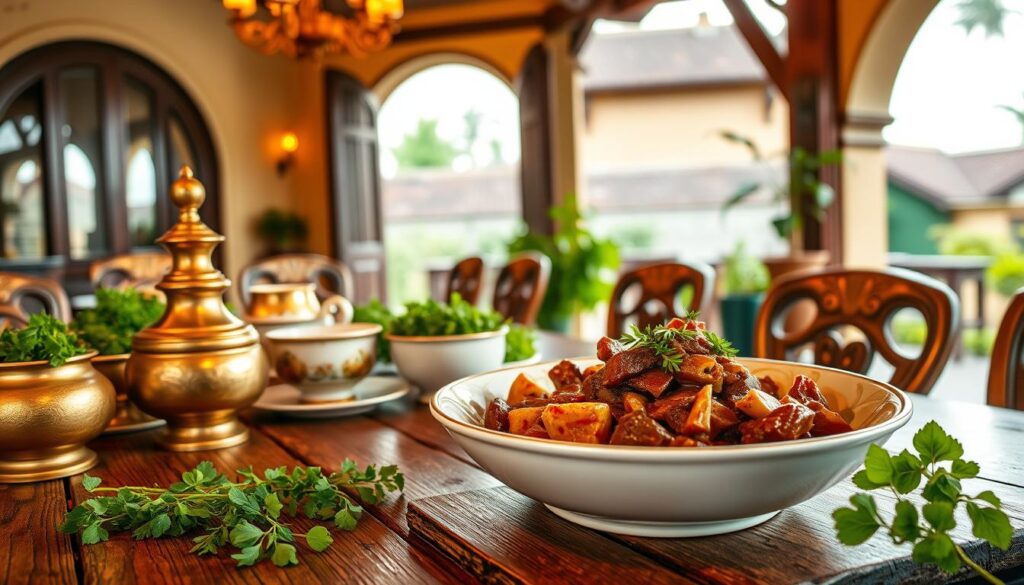
Vegetarian and Vegan Options in Vietnamese Cuisine
Vietnam offers a rich array of vegetarian Vietnamese dishes that showcase the country’s vibrant culinary traditions. With a growing awareness of plant-based diets, many travelers are actively seeking vegan and vegetarian options during their visits. The culinary landscape reflects this demand, with a significant number of restaurants adapting their menus to accommodate these preferences. You will find that authentic Vietnamese food includes numerous delicious meat-free options, ensuring a delightful dining experience.
Popular Vegetarian Dishes to Consider
Vietnam boasts a variety of vegetarian dishes that can cater to your taste buds. Some popular choices include:
- Phở Chay: A vegetarian version of the iconic noodle soup, prepared with a rich vegetable broth and an assortment of mushrooms and veggies.
- Bánh Mì Chay: This flavorful sandwich replaces meat with fresh vegetables and tofu or egg, offering a satisfying meal.
- Gỏi Cuốn Chay: These fresh spring rolls are filled with an array of vegetables, tofu, and vermicelli noodles, making for a light, refreshing snack.
- Cơm Chay Dập: A hearty vegetarian rice dish topped with delicious vegetables and tofu.
- Chả Giò Chay: Crispy vegetarian spring rolls filled with tofu and vegetables, served with a sweet and sour dipping sauce.
| Dishes | Main Ingredients | Average Price (VND) |
|---|---|---|
| Phở Chay | Mushrooms, vegetables, noodles | 30,000 – 50,000 |
| Bánh Mì Chay | Tofu, fresh veggies | 30,000 – 50,000 |
| Gỏi Cuốn Chay | Rice paper, tofu, vermicelli | 20,000 – 45,000 |
| Chả Giò Chay | Tofu, vegetables | 25,000 – 50,000 |
| Cơm Chay Dập | Vegetables, tofu, rice | 30,000 – 60,000 |
Navigating Vietnamese Menus as a Vegan
When dining at Vietnamese restaurants, it’s essential to recognize the term “chay,” which indicates vegetarian options. Often, many dishes can be made vegan with minor substitutions. For instance, a simple request can replace meat with tofu or additional vegetables in traditional recipes. Look for these popular vegan-friendly offerings:
- Xôi Chay: A street food favorite featuring sticky rice with vegetarian ingredients, perfect as a snack.
- Lẩu Chay: A comforting vegetarian hot pot made from vegetable broth paired with mushrooms and tofu.
- Chè Chay: A delicious sweet dessert that highlights beans, fruits, and coconut milk.
Embracing vegetarian and vegan dishes in Vietnam allows you to enjoy the country’s culinary richness without sacrificing your dietary choices. You will be surprised by the variety and flavors available, making your dining experience not just satisfying but also unforgettable.

How to Prepare Vietnamese Dishes at Home
Preparing Vietnamese dishes at home can be an exciting culinary journey. Familiarity with essential ingredients and simple recipes will ease your transition into this flavorful cuisine. By mastering Vietnamese cooking techniques, you will create traditional Vietnamese recipes that reflect authentic flavors.
Must-Have Ingredients for Your Kitchen
To replicate the vibrant flavors of Vietnamese cuisine, stock your kitchen with a few essential ingredients. Here are some staples you should have on hand:
- Rice: A major staple, used in various forms from steamed to broken rice dishes.
- Fish Sauce (Nước Mắm): A critical condiment that adds depth to many dishes.
- Herbs: Fresh herbs like basil, cilantro, and mint play a key role in enhancing flavor.
- Noodles: Different types such as rice noodles for pho and vermicelli for bún.
- Vegetables: Fresh produce enriches your meals, balancing flavors and adding nutrition.
Simple Recipes to Get You Started
Start with these popular dishes to familiarize yourself with Vietnamese cooking techniques:
- Pho: This iconic noodle soup features a fragrant broth, rice noodles, and various toppings. The average preparation time ranges from 1 to 2 hours, depending on the recipe’s complexity.
- Banh Mi: A beloved sandwich, typically made with a baguette filled with meats, pickled vegetables, and sauces. While it’s often purchased from street vendors, making it at home can be a fun experience.
- Goi Cuon (Fresh Spring Rolls): These refreshing rolls filled with shrimp, herbs, and rice noodles offer a light appetizer option.

By trying these recipes, you will enhance your confidence in preparing traditional Vietnamese recipes. Engaging with culinary classes can further deepen your understanding and assist you in mastering more complex dishes. Embrace these vibrant flavors and enjoy the delightful process of cooking Vietnamese food at home.
Eating Etiquette in Vietnamese Culture
Understanding the dining customs in Vietnam can enhance your experience with authentic Vietnamese food. Meals in Vietnam often emphasize community and respect, demonstrating the cultural significance of shared dining. Observing proper etiquette not only reflects your appreciation of Vietnamese cuisine but also helps you connect with your dining companions.
Understanding Vietnamese Dining Customs
In a typical Vietnamese meal, the male head of the family usually takes the most prominent seat and is served first. This practice underscores the importance of hierarchy in Vietnamese culture. Guests should be attentive, as it is polite to serve others before themselves. Chopsticks serve as the primary utensils for enjoying meals, particularly when sharing dishes, highlighting the communal aspect of dining.
Both hands should remain on the table during meals, which facilitates the use of chopsticks and rice bowls. Each person at the table is provided with chopsticks and a rice bowl, reinforcing the cultural connection to authentic Vietnamese food. Personalizing your dish is common, where you can add fresh ingredients like herbs and bean sprouts before indulging. Polite conversation during meals entails complimenting the food and discussing recipes, showcasing respect for the cook.
Tipping Practices in Vietnam
Tipping in Vietnam is appreciated but not mandatory. At restaurants, it’s customary to leave small change or round up the bill, reflecting your gratitude for the service. When dining in a group, the eldest or highest-ranking individual often pays the bill first, an act that signifies respect and social hierarchy.
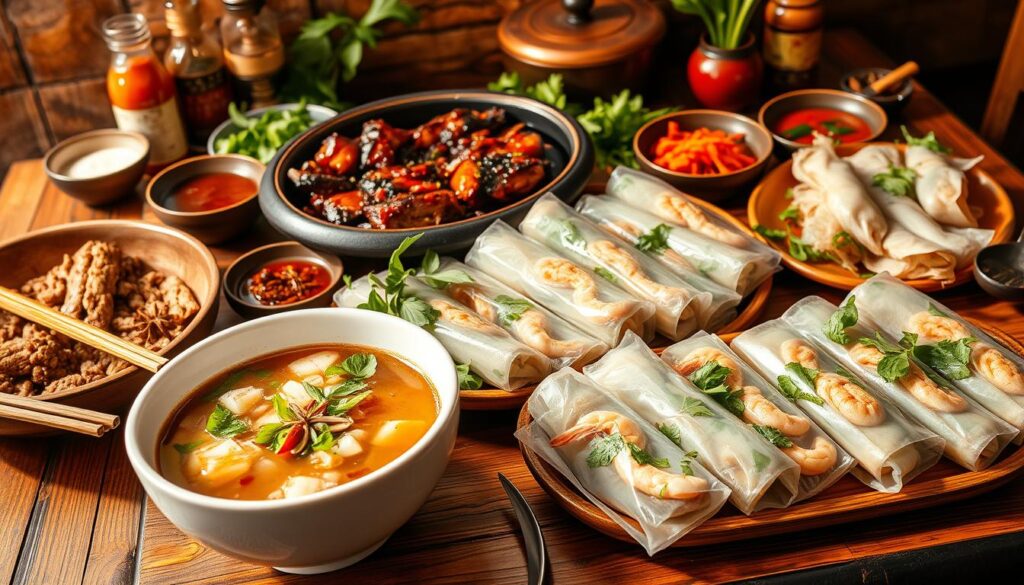
Healthy Aspects of Vietnamese Cuisine
Healthy Vietnamese cuisine stands out due to its emphasis on fresh, natural ingredients. You will discover a vibrant array of herbs and vegetables, each contributing to a nutritious dining experience. This cuisine not only tantalizes the taste buds but also promotes overall well-being.
Fresh Ingredients and Their Benefits
Fresh herbs such as mint, cilantro, and basil are frequently used in Vietnamese dishes. These herbs are rich in vitamins and antioxidants, enhancing your immune system while aiding digestion. A variety of vegetables high in fiber, vitamins, and minerals are essential components of many meals, promoting digestion and supporting weight management. With a low use of oil in cooking methods, the nutritional integrity of ingredients is preserved, making the food both healthy and delicious.
- Lean proteins, including fish, chicken, and tofu, serve as staples in this cuisine, providing essential amino acids while remaining low in fat.
- Fish is particularly noted for its omega-3 fatty acids, which contribute to heart health and cognitive function.
- Lemongrass and ginger not only enhance flavor but also offer health benefits. Lemongrass has anti-inflammatory properties, while ginger is recognized for immune-boosting abilities.
- Turmeric, a common ingredient in Vietnamese dishes, improves brain health and may reduce the risk of chronic diseases.
Low-Calorie Options to Taste
The beauty of healthy Vietnamese cuisine lies in its low-calorie options. Dishes like pho and fresh spring rolls (goi cuon) are perfect for those seeking nutritious yet low-calorie meals.
| Dish | Calories | Benefits |
|---|---|---|
| Pho | Approx. 350 | High in fiber and packed with vitamins and minerals. |
| Go Cuon | Approx. 50 each | Filled with fresh vegetables and protein, rich in nutrients. |
| Banh Mi | Approx. 500 | Balanced meal with protein and whole-grain bread offering sustenance. |
You can always enjoy healthy Vietnamese cuisine while indulging in delicious flavors and fresh ingredients, ensuring a fulfilling and nourishing experience. Give these dishes a try to delight your palate and support your health journey!

Vietnamese Beverages to Complement Your Meals
When indulging in authentic Vietnamese food, pairing the right beverages can significantly enhance your dining experience. Vietnam offers a diverse range of Vietnamese beverage options, from traditional drinks to unique coffee styles that perfectly complement the flavors of the cuisine. Discover how these beverages can elevate your meals and provide a refreshing balance to the dishes you enjoy.
Traditional Drinks to Try
Traditional Vietnamese drinks play a vital role in the country’s culinary culture. Common options include:
- Trà (tea): A staple in Vietnamese households, available in various types, including green and herbal blends.
- Nước dừa (coconut water): This refreshing drink is delightful and hydrating, especially during the hot summer months.
- Nước sâm: An herbal tea known for its cooling properties, made from ingredients like sugar cane and nettle leaves.
Popular Coffee Styles in Vietnam
Vietnamese coffee is renowned for its distinctive flavor, largely thanks to the use of Robusta beans and the traditional brewing methods. Common styles include:
- Cà phê sữa đá: This iced coffee blended with sweet condensed milk is a favorite among locals, providing a rich and creamy experience.
- Cà phê đá: A simpler iced black coffee often sweetened to taste, this style remains popular for its bold flavor.
- Cà phê trứng: Also known as egg coffee, this unique blend features whipped egg yolk, sugar, and condensed milk, resulting in a luxurious treat.
Pairing drinks thoughtfully can enhance your authentic Vietnamese food experience. Consider enjoying summer rolls with a glass of dry Riesling, or savoring Pho with iced coffee for a refreshing touch. Embrace these Vietnamese beverage options to complement your meals perfectly.
| Dish | Recommended Beverage |
|---|---|
| Banh Xeo | Italian Prosecco |
| Bo Kho | Bordeaux Merlot |
| Pho Bo | Spanish Cava |
| Summer Rolls | German Dry Riesling |
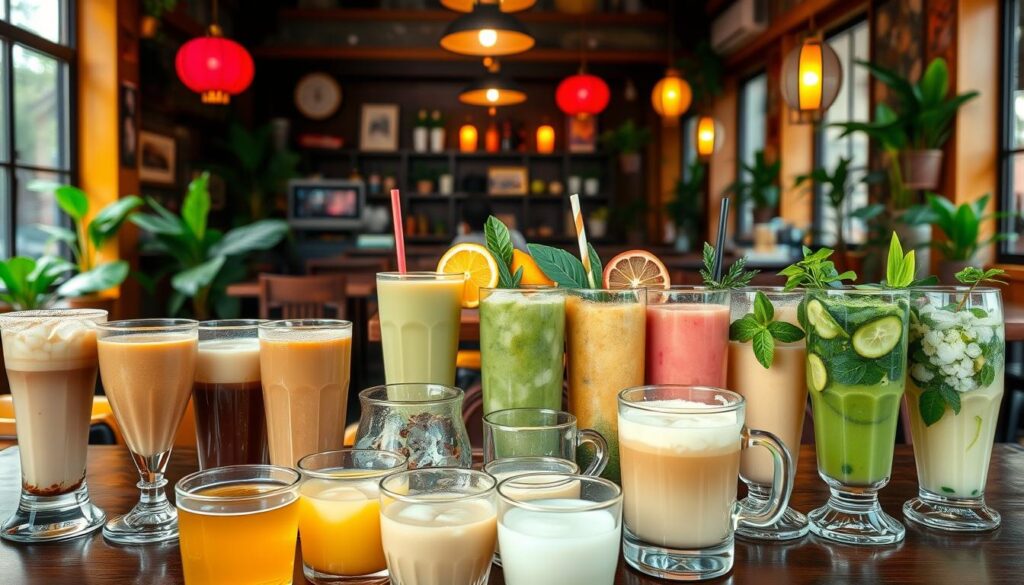
The Joy of Vietnamese Desserts
Vietnamese desserts present a delightful adventure into the country’s rich culinary heritage. These sweet treats often use an array of diverse ingredients, making them a unique fusion of flavors and textures. Each dessert tells a story, reflecting the cultural depth and creativity of traditional Vietnamese recipes.
Sweet Treats You Shouldn’t Miss
Don’t miss out on the amazing variety of Vietnamese desserts. Here are a few highlights:
- Chè: A versatile sweet soup that combines mung beans, coconut milk, glutinous rice, and tropical fruits, making each serving a visual and culinary delight.
- Xôi Xéo: A sticky rice dish infused with turmeric, it presents a beautiful golden color and offers a balance of sweetness and nuttiness.
- Bánh Chuối Nếp Nướng: This dessert features grilled bananas wrapped in sticky rice and banana leaves, showcasing the country’s love for tropical fruits.
- Bánh Bò: Known as honeycomb cake, its texture and taste have been cherished in Vietnam for generations.
Traditional Desserts and Their Ingredients
Traditional Vietnamese recipes often emphasize glutinous rice as a staple, providing a unique sticky texture essential for many treats. A few notable desserts include:
- Bánh Flan: A Vietnamese twist on crème caramel, topped with a glossy caramel glaze, this dessert captivates with its smooth texture.
- Chè Thái: Noted for its vibrant presentation, this dessert features a coconut pavlova and fruit ice cream, representing the marriage of traditional tastes with modern techniques.
- Tào Phớ: A comforting soybean pudding that brings both flavor and nostalgia.
Modern takes on these classic Vietnamese desserts can be found at restaurants like Ramie, where innovative pastry chef Trinh Nguyen merges traditional flavors with international influences. Such efforts showcase the evolving landscape of Vietnamese desserts, offering you a perfect blend of the old and the new.
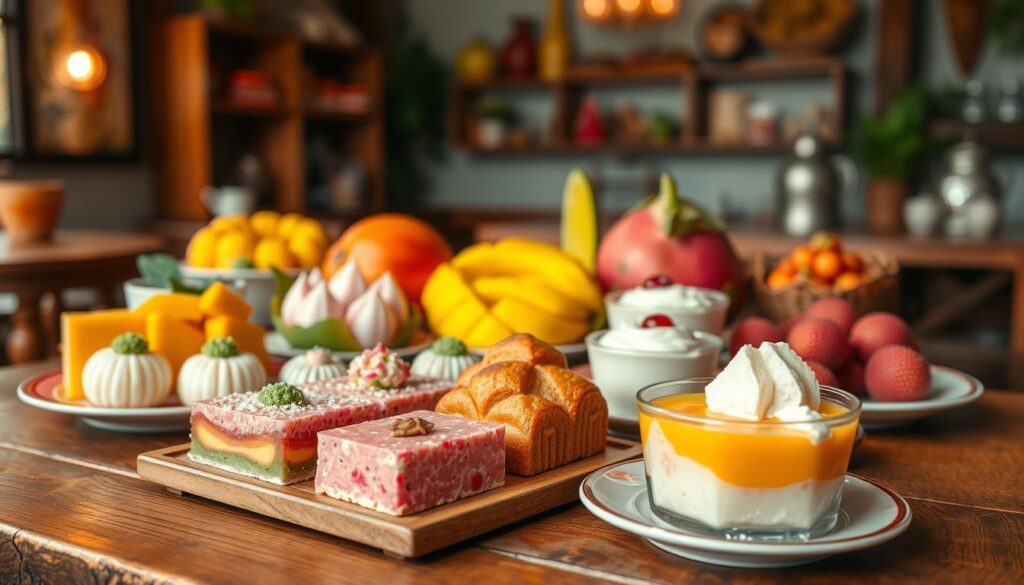
Conclusion: Embrace Vietnamese Cuisine in Your Life
Embracing Vietnamese cuisine means embarking on a flavorful journey filled with vibrant ingredients and healthy choices. Whether you’re a culinary enthusiast or a casual diner, discovering the best Vietnamese restaurants near you can elevate your dining experience. Utilize food review platforms, apps, or local guides to locate eateries that offer authentic Vietnamese dishes, satisfying both your taste buds and your curiosity for unique flavors.
How to Find Vietnamese Restaurants Near You
Finding the best Vietnamese restaurants can be a delightful adventure. Many establishments offer a diverse range of delectable options, from the iconic pho to fresh spring rolls. You may find it beneficial to seek out places that highlight traditional Vietnamese recipes while also exploring how contemporary influences shape this beloved cuisine. With the increasing demand for healthy dining, many Vietnamese eateries are showcasing nutritious ingredients that align with modern dietary needs.
Making Vietnamese Food Your Own at Home
Creating Vietnamese cuisine in your kitchen allows you to experiment with traditional recipes, tailoring them to your personal taste. Start by gathering essential ingredients like rice noodles, fresh herbs, and fish sauce, which are foundational to many dishes. By adjusting recipes to suit your flavor preferences while maintaining their authentic essence, you can bring the unique tastes of Vietnam straight to your dining table. This hands-on experience not only enhances your cooking skills but also brings a piece of Vietnam into your home.
